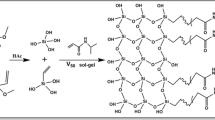Summary
Poly(butylene glycol) (PBG) samples of widely differing molecular weight (M), either in the native form or as the corresponding α, ω-bis(1-naphthyl)urethane derivatives, have been subjected to reversed-phase high-performance liquid chromatography (gRPHPLC) on an octadecylsilyl (C18) silica gel stationary phase with mobile phase gradients comprising binary eluent systems prepared from tetrahydrofuran (THF) and water and from acetone and water, and with ternary systems prepared from acetonitrile, THF and water and from methanol, THF and water.
Because of the lack of a chromophore in the PBG they were detected both by evaporative light-scattering detection (ELSD) and, after conversion to the α, ω-bis(1-naphthyl)urethane derivatives with 1-naphthylisocyanate, by UV monitoring at 280 nm.
In general, sufficient resolution of the oligomers of low-M samples, i.e. PBG 650 and PBG 1000, was achieved with all the gradient systems used, and resolution increased in the order acetone-water < THF-water < methanol-THF-water< acetonitrile-THF-water. Whereas the difference between chromatographic resolution (R R ) was relatively moderate for PBG 650 and PBG 1000 for all the solvent-non-solvent combinations used, values were much larger for the high-M samples PGB 2000 and PBG 3000 either in the native form or as their α, ω-bis(1-naphthyl)urethane derivatives. No separation of the high-M oligomers of PBG 3000 was obtained with acetone-water and THF-water gradients and a common signal envelope was observed for these sample constituents In contrast, acetonitrile-THF-water and methanol-THF-water ternary gradients effected satisfactory resolution of large amounts of oligomers and more than 70 oligomer peaks were recognizable. Chromatographic resolution (R S ) of high-M oligomer was markedly better with acetonitrile-THF-water than with methanol-THF-water.
Use of the α, ω-bis(1-naththyl)urethane derivative of PBG 2000 as model component for fluorescence detection, with excitation and emission wavelengths of 232 and 358 nm, respectively, resulted in either improved detection sensitivity or much cleaner chromatograms and thus better selectivity compared with measurement of UV response at 280 nm.
The effect of the different mobile-phase systems on the separations of these solutes is explained in terms of distribution of the solute molecules between the bulk mobile phase and the hydrophobic network ofC 18 chains, bound to the surface of the silica gel base material. In this respect, the eluent strength of an organic modifier increases with increasing solubility and/or solvation characteristics, in particular for the high-M fractions. It had, nevertheless, to be taken into consideration that solvents that were too “good” afforded efficient sample elution on the one hand but markedly impaired oligomer resolution on the other, as shown by separation of the high-M sample constituents by binary THF-water and acetone-water gradients.
Similar content being viewed by others
References
K. Rissler, H. -P. Künzi, H. -J. Grether, J. Chromatogr.,635, 89 (1993).
K. Rissler, U. Fuchslueger, H. -J. Grether, J. Chromatogr. A,654, 309 (1993).
K. Rissler, U. Fuchslueger, J. Liq. Chromatogr.,17, 2791 (1994).
K. Rissler, J. Chromatogr. A,786, 85 (1997).
K. Rissler, J. Chromatogr., A,871, 243 (2000).
K. Rissler, N. Wyttenbach, K. O. Börnsen, J. Chromatogr. A,822, 89 (1998).
K. Rissler, J. Efer, W. Engewald, G. Glöckner (manuscript in preparation).
W. A. Dark, E. C. Conrad, L. W. Crossman, J. Chromatogr.,91, 247 (1974).
G. L. Hagnauer, D. A. Dunn, Ind. Eng. Chem. Prod. Res. Dev.,21, 68 (1982).
B. Klumperman, P. Cools, H. Philipsen, W. Staal, Macromol. Symp.,110 1 (1996).
H. J. A. Philpsen, B. Klumperman, A. L. German, J. Chromatogr. A,746, 211 (1996).
H. J. A. Philpsen, M. R. de Cooker, H. A. Claessens, B. Klumperman, A. L. German, J. Chromatogr. A,761, 147 (1997).
H. J. A. Philpsen, M. Oestreich, B. Klumperman, A. L. German, J. Chromatogr. A,775, 157 (1997).
H. J. A. Philpsen, H. A. Claessens, H. Lind, B. Klumperman, A. L. German, J. Chromatogr. A,790, 101 (1997).
H. J. A. Philpsen, H. A. Claessens, M. Bosman, B. Klumperman, A. L. German, Chromatographia,48, 623 (1998).
M. W. F. Nielen, F. A. Buitenhuijs, Anal. Chem.,71, 1809 (1999).
K. Rissler, U. Fuchslueger, H. -J. Grether, J. Liq. Chromatogr.17, 3109 (1994).
P. Jandera, M. Holcapek, G. Theodoridis, J. Chromatogr. A.,813, 299 (1998).
G. Guiochon, G. Moysan, C. Holley, J. Liq. Chromatogr.,11, 2447 (1988).
R. Schultz, H. Engelhardt, Chromatographia29, 517 (1990).
J. M. Charlesworth, Anal. Chem.,50, 1414 (1978).
T. H. Mourey, L. E. Oppenheimer, Anal. Chem.,56, 2427 (1984).
L. E. Oppenheimer, T. H. Mourey, J. Chromatogr.,323, 297 (1985).
P. Van der Meeren, J. Vanderdeelen, L. Baert, Anal. Chem.,64, 1056 (1992).
A. Stolyhwo, H. Colin, G. Guiochon, J. Chromatogr.,265, 1 (1983).
A. Stolyhwo, H. Colin, M. Martin, G. Guiochon, J. Chromatogr.,288, 253 (1984).
A. Stolyhwo, M. Martin, G. Guiochon, J. Liq. Chromatogr.,10, 1237 (1987).
W. R. Melander, A. Nahum, C. Horváth, J. Chromatogr.,185, 129 (1979).
T. Okada, Anal. Chim. Acta,281, 85 (1993).
Author information
Authors and Affiliations
Rights and permissions
About this article
Cite this article
Rissler, K. Improved separation of poly(butylene glycol) oligomers on a C18 column by gradient reversed-phase liquid chromatography and fine-tuning of the organic modifier system. Chromatographia 51, 656–668 (2000). https://doi.org/10.1007/BF02505403
Received:
Revised:
Accepted:
Issue Date:
DOI: https://doi.org/10.1007/BF02505403




